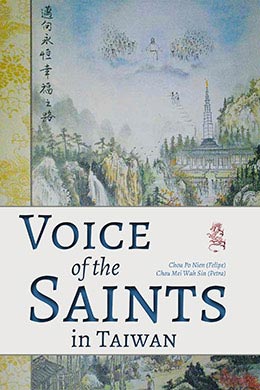Dawn of a New Rising Generation
Early-Morning Seminary and Preach My Gospel (2000–2004)
Chou Po Nien (Felipe) (周伯彥) and Chou Sin Mei Wah (Petra) (周冼美華), “Dawn of a Rising Generation: Early-Morning Seminary and Preach My Gospel (2000-2004),” in Voice of the Saints in Taiwan, ed. Po Nien (Felipe) Chou (周伯彥) and Petra Mei Wah Sin Chou (周冼美華) (Provo, UT: Religious Studies Center; Salt Lake City: Deseret Book, 2017), 287-322.
This period of the Church in Taiwan welcomed the dawn of a new rising generation of Latter-day-Saint youth in Taiwan. Both early-morning seminary and Preach My Gospel prepared the rising generation to face the challenges of the twenty-first century. After the arrival of a new Asia Area Presidency in 1998, preparations were made to start early-morning seminary programs and purchase land for new meetinghouses to accommodate the growth of the Church in Taiwan. In addition, after the worldwide broadcast of the Nauvoo Temple dedication, satellite broadcasts allowed members in Taiwan to participate in general conference. The call of Area Seventies in Taiwan, visits with Church and government leaders, updated translation of the Chinese name of the Church, and the introduction of Preach My Gospel furthered the cause of Zion in Taiwan. Each of these important events at the beginning of the twenty first century prepared the Church for continual expansion and grow in Taiwan. Church membership had grown to 26,805 people in the nearly four-and-a-half decades spanning from 1956 to 1999, and more than double that in the next fifteen years.
Early-morning Seminary & Institute Developments
Inspired Changes Lead to Growth and Expansion
In 1999, the Asia Area Presidency—Cree-L Kofford, Richard E. Cook, and H. Bryan Richards[1]—spearheaded an effort to increase seminary enrollment and to convert the home study seminary programs into early-morning classes in Taiwan. At that time, no ongoing early-morning seminary programs functioned on the island except for one in an expatriate branch.
However, several obstacles existed, the most significant being the students’ school and study schedule. Students generally attended school from seven thirty a.m. until five thirty p.m., followed by “cram school” (test preparation classes) from 6:30 until 9:30 p.m., followed by daily homework. There were concerns that changing home study to early-morning seminary would require a significant sacrifice of time, both for students and their parents. Initial attempts in the late 1990s to introduce early-morning seminary throughout Taiwan were largely short-lived. In short, many felt that there just was not enough time in the day to expect the LDS youth to sacrifice for an early-morning seminary class.
Reopening of the Kaohsiung Office
Elder Cree-L Kofford, the Asia Area President, visited Stan Peterson, CES administrator of Seminaries and Institutes of Religion, and Ross Cole, the zone administrator over Asia, to request assistance regarding how to establish early-morning seminary in Taiwan.[2] About this same time in the southern region of the island, Lee Shih-Jung (Robert) (李世榮) had been called as the new stake president of the Kaohsiung Stake. On 19 October 1999, Elder Jeffrey R. Holland of the Quorum of the Twelve and Elder Kofford visited the Kaohsiung Stake, and President Lee asked for assistance in creating an early-morning seminary program in southern Taiwan. Shortly thereafter, in consultation with the Asia Area Presidency, CES officials in Salt Lake felt that the timing was right to send Chou Po Nien (Felipe) (周伯彥), a newly hired released-time seminary teacher in Utah, to reopen the Kaohsiung office and begin an early-morning seminary class.[3]
In January 2000, Elders Kofford and Cook (from the Asia Area Presidency) held a series of meetings throughout Taiwan, encouraging leaders and members to enroll more seminary students and organize early-morning seminaries, promising the students that if they would support the program they would do better in school. Furthermore, they would arrive to school already awake, be more prepared, and need less study time outside of class.[4]
On 18 January 2000, Chou Po Nien (Felipe) (周伯彥) and his wife, Chou Sin Mei Wah (Petra) (周冼美華), moved their young family to Taiwan to reopen the Kaohsiung office and coordinate the CES programs in the southern region of the island. When they moved to Taiwan, they had a one-year-old boy and were expecting their second child, which made the move challenging.[5] Although Brother Chou was born in Taiwan, his family left when he was two years old, and he did not learn Mandarin growing up. Petra, a native of Hong Kong, grew up speaking Cantonese but learned Mandarin on her LDS mission, which proved to be of great assistance to her husband’s limited language skills during their first year in Taiwan. With persistence and his wife’s help, Chou learned the language quickly. His secretary, Yan Shu-Wen (楊舒文), played a critical role in translating correspondence and tracking enrollment and completion efforts.
Although it was in the middle of the school year when the Chous arrived in Taiwan, Chou immediately began preparations for the first early-morning seminary class in Kaohsiung under the direction of President Lee. After securing housing and following the two-week Chinese New Year’s break, the Kaohsiung Stake presidency (Lee, Yang, and Chen) organized a youth conference (18–20 February 2000) for their stake and invited Chou to introduce and encourage enrollment in early-morning seminary. With tremendous effort and support from the stake presidency, bishops, and parents in the Kaohsiung Stake, twenty-three students registered for the class at the Kaohsiung stake center to be taught by Brother Chou; and seven registered for the class at the Fengshan meetinghouse, to be taught by Kho Yu-Lan (郭玉蘭), a volunteer teacher.[6]
Early-Morning Seminary Pioneers in Southern Taiwan
On 29 February 2000, the students who attended the first early-morning classes in the Kaohsiung Stake came by car, scooter, or bicycle; but all who came demonstrated great faith and sacrifice to participate in pioneering the early-morning seminary program. At the conclusion of the school year four months later, twenty-two of the thirty early-morning seminary students in the stake received credit by attending at least 80 percent of classes, thus establishing early-morning seminary in Taiwan.[7]
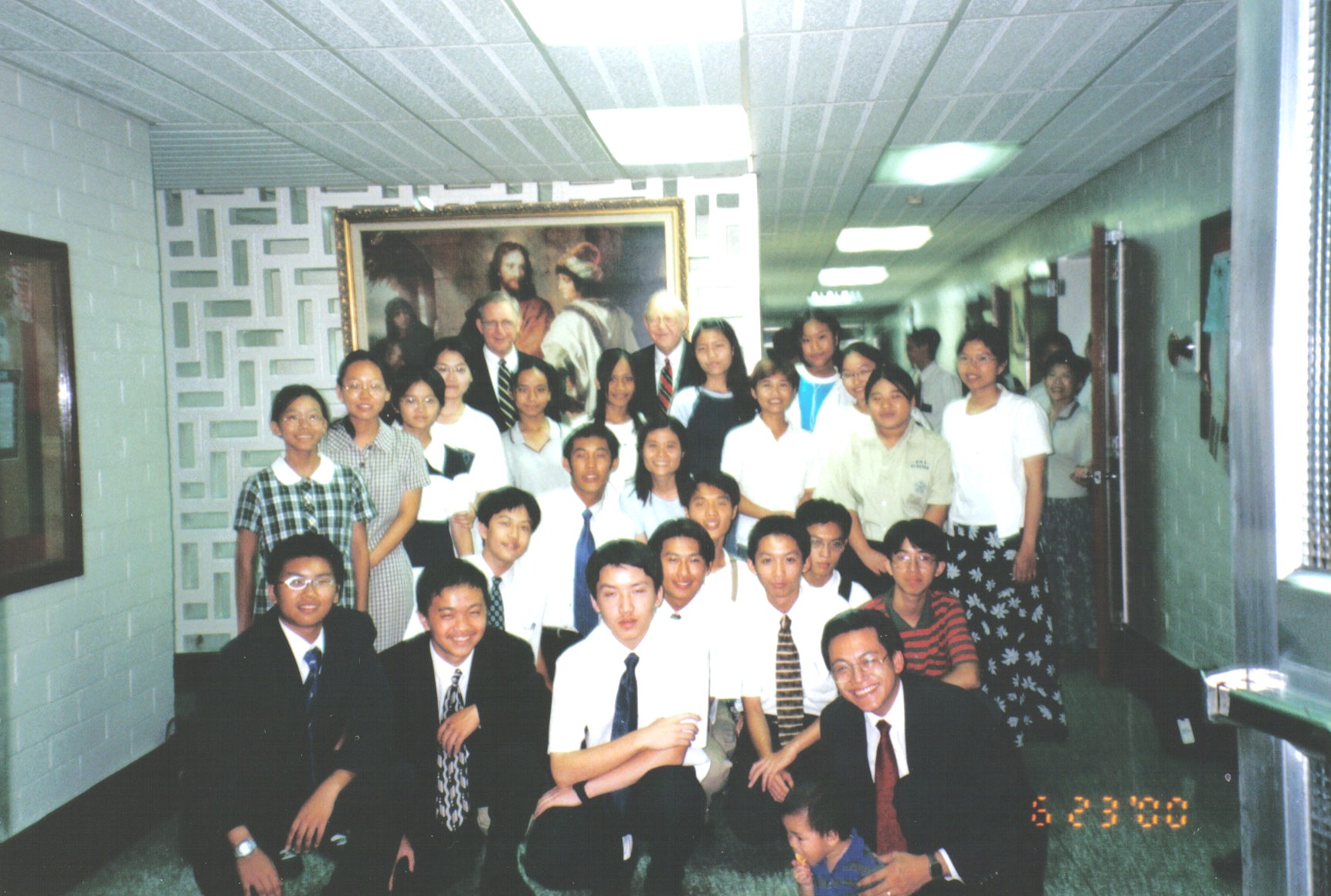 Kaohsiung early-morning seminary graduation with Presidents Kofford and Richards from the Asia Area Presidency on 23 June 2000. Courtesy of Chou Po Nien (Felipe).
Kaohsiung early-morning seminary graduation with Presidents Kofford and Richards from the Asia Area Presidency on 23 June 2000. Courtesy of Chou Po Nien (Felipe).
On the evening of 23 June 2000, a seminary graduation was held at the Kaohsiung stake center, with Elders Kofford and Richards in attendance.[8] A choir of early-morning seminary students sang “We’ll Bring the World His Truth,” followed by talks from the two members of the area presidency. After hugging each student and expressing gratitude for their faith, President Kofford talked about an experience he had three years earlier in a meeting with leaders in Taiwan and the strong impression he had that the time had come for Taiwan to have early-morning seminary to strengthen the future of the Church in Taiwan. [9] These students became the “vanguard pioneers company” of early-morning seminary in Taiwan, paving the way for others to follow.
Expanding Early-Morning Seminary to Central & Northern Taiwan
A video of the Kaohsiung early-morning seminary program (including a typical class experience, along with testimonies of leaders, parents, and students) was produced and used to promote early-morning seminary in other stakes and districts throughout Taiwan. The success of the early-morning program in the south led to additional classes established in May and June 2000 by Wang Lu Pao (王綠寶) in the northern region of Taiwan, as well as classes in the central region of Taichung by Chou.[10]
The beginning of the first Taichung early-morning seminary class parallels the experience in Kaohsiung. With tremendous support from the stake presidency and other Church leaders, as well as parents and students, this first early-morning seminary class in central Taiwan began with twenty-one students on 28 August 2000. The dedication of stake leaders in Taichung to help the parents and youth understand the importance of early-morning seminary could not be mistaken. Brother Lin (林弟兄), a member of the stake high council, was released from the high council to serve as the first early-morning seminary teacher for this class. Members of the stake presidency and the bishops visited the class regularly to bring breakfast for the youth and encourage them to maintain their attendance to qualify for completion and graduation. After Lin was released as an early-morning seminary teacher, President Juan Jui-Chang (阮瑞昌), the Taichung Stake president (and later an Area Authority Seventy), served as an early-morning seminary teacher for a period of time while concurrently presiding over the stake.[11]
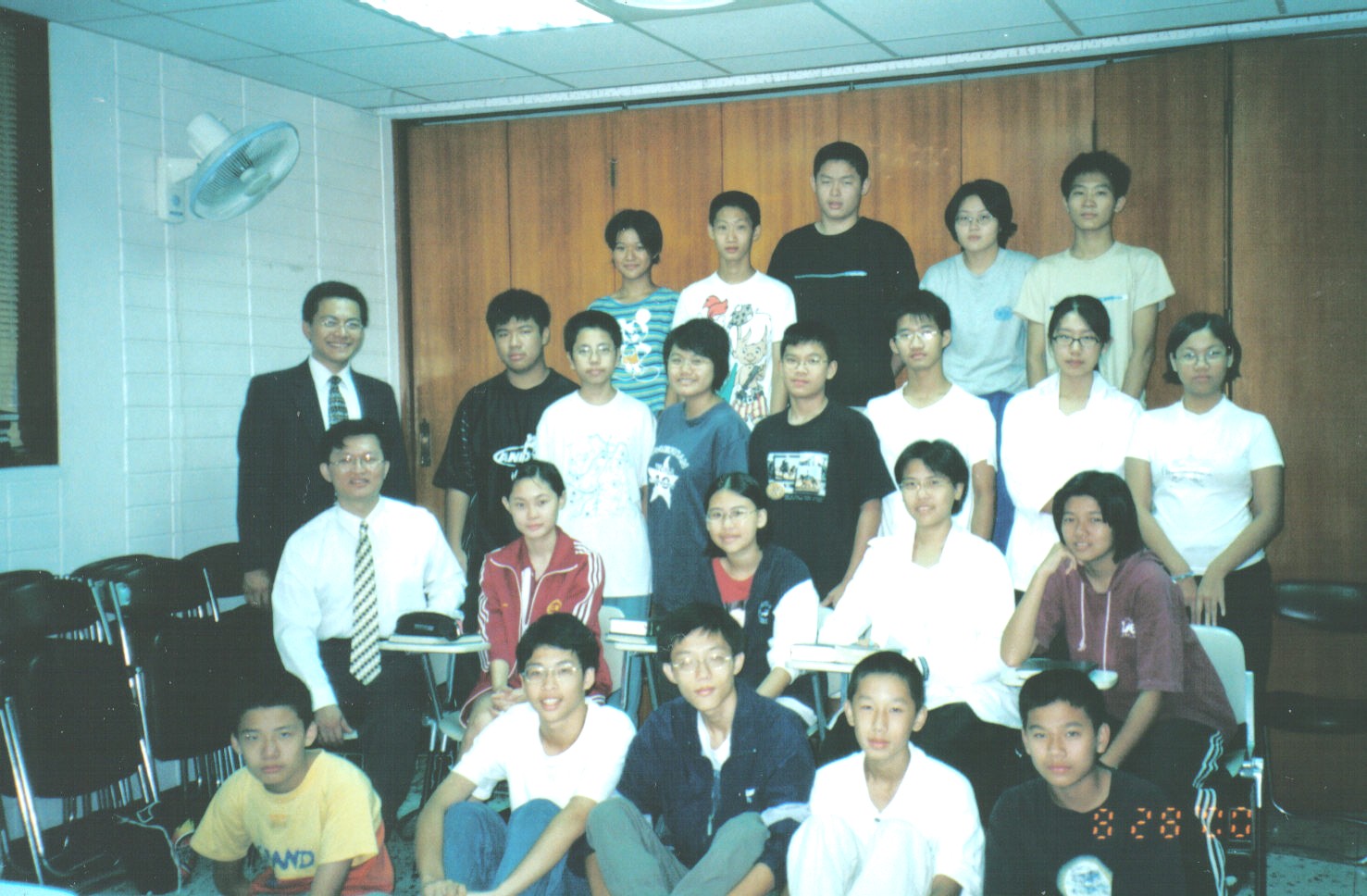 Taichung early-morning seminary class on 28 August 2000. Courtesy of Chou Po Nien (Felipe).
Taichung early-morning seminary class on 28 August 2000. Courtesy of Chou Po Nien (Felipe).
Besides the principal cities of Kaohsiung, Taichung, and Taipei, early-morning classes were also established in other cities, including Taoyuan, Hsinchu, Nantou, Changhua, Chiayi, Tainan, Pingtung, and others. By January 2001, Wang and Chou’s combined efforts resulted in increased seminary enrollment and the establishment of early-morning classes in every stake in Taiwan. After the establishment of the first early-morning seminary class in Kaohsiung, seminary enrollment increased dramatically from 257 in 1998–99 (9 early-morning, 248 home study), to 345 in 1999–2000 (61 early-morning, 284 home study), to 402 in 2000–2001 (213 early-morning, 189 home study), to 480 in 2001–2 (296 early-morning, 184 home study).[12] According to many Church leaders, establishing early-morning seminary in Taiwan was nothing short of a miracle brought about by the faith and sacrifice of parents, teachers, and students.
Lee Tsai Shu-Min (Bridget) (李蔡淑敏), one of the first early-morning seminary teachers in Kaohsiung, also experienced both difficulties and rewards. She arrived for her classes at the chapel each day, ready to teach her students. However, no students came for several days. When it was suggested to her that she might consider going home if no students came after several minutes, she responded that the Lord called her to be there for the whole class period and she would stay until the very last minute, even if no students came. The ward members told the students they should be ashamed to make Sister Lee sit in class alone every day, and soon students began attending and later expressed gratitude that her teacher never gave up on them. Tsai’s determination and perseverance are a legacy that continues to inspire seminary teachers today.[13]
Several of the first students that transitioned from home study to early-morning seminary reported that getting up so early in the morning was very hard, especially when it was cold and dark outside. Nevertheless, many of these students also expressed gratitude for their teachers, leaders, and parents who supported them. Sister Feng Huang Shang-Hua (馮黃上華) from Kaohsiung said that “before early-morning seminary started, the school always sent me notification that my son was constantly tardy; but after he began to attend early-morning seminary, he was never late to school.”[14]
Promises and Blessings from Early-Morning Seminary
When early-morning programs started, there were concerns that attendance might adversely affect grades and educational opportunities for these youth. The Asia Area Presidency responded with a promise that those who attended seminary would become the best students in Taiwan.[15]
Feng Cho-Chien (Jimmy) (馮卓健), the first early-morning seminary class president in Kaohsiung, attended early-morning seminary faithfully, but he received grim news that his early admission application to a local college was rejected. Like other students, he had to decide between attending the newly organized early-morning seminary class or take additional cram and tutoring classes instead to prepare for the national college entrance exam. He chose to continue with early-morning seminary. When he took the national college entrance exam the summer following successful completion of early-morning seminary, he placed in the top one hundred students out of the over sixty-seven thousand students who took the national exam that year. He went on to attend Tai-Da University, the country’s most prestigious university, served a full-time mission, and was sealed to his wife in the Taipei temple. Many other students likewise testified of the blessing of early-morning seminary to them and their families.[16]
President Chang Chih-Hsun (張志勳), then first counselor in the Taichung Stake presidency, invited his nonmember brother to drive his sons to early-morning seminary. This man went from waiting for his nephews by sleeping in the car in the parking lot, to having gospel discussions with other parents outside of the class, to meeting with the missionaries, and ultimately becoming a member of the Church. According to Chang, waiting for the boys to finish early-morning seminary resulted in his joining the Church. [17]
Huang Shang Ting (黃湘婷), an early-morning seminary student in Kaohsiung, shared with her nonmember father a lesson she learned in seminary about temples and the concept of eternal families. After listening to his daughter share her desire that they might one day be an eternal family, he was baptized and brought his less-active wife back to the Church. They were later sealed as an eternal family in the Taipei Taiwan Temple, and he was called to serve as a branch president.[18]
The Asia Area Presidency encouraged CES teachers and leaders to renew their efforts to reach out and invite new converts and less-active members to participate in seminary and institute. When Kuo Tseng Tsai-Fen (郭曾彩鳳) from Toufen was asked to serve as a volunteer seminary teacher, not a single seminary student attended in her branch. However, after consultation with the CES coordinator, she contacted ten converts in her branch who were seminary age but who did not attend church, and six of them enrolled immediately. While the nonmember parents of these seminary-age converts objected to their attending church on Sundays, they did not restrict their children from attending seminary classes held during the week.[19]
These recruitment efforts also took place in institute. For example, in Hsiao Kang, Sister Chou Sin Mei Wah’s (Petra) (周冼美華) class started with two institute students, but by the end of the semester over thirty attended, nearly all of whom were new converts.[20] Institute enrollment in Taiwan grew from 1,279 in the 1998–99 school year to 2,665 in 2001–2.
Institute “Gathering” of YSAs and First Institute Councils
Besides inviting new converts to institute classes, other changes helped the institute program grow and expand. Changes to institute programs also included gathering young single adults into larger classes, installing the first institute councils, expanding institute course offerings, and establishing summer institute classes.
The establishment of institute classes in nearly every ward and branch was a significant undertaking in the 1980s and early 1990s. However, by the late 1990s, a large portion of institute students were married and over the age of thirty, resulting in many young single adults (YSA) between the ages of eighteen and thirty choosing not to attend institute. One ward had forty-five YSAs, but only five attended institute. Typically, a ward or branch institute class had twelve to fifteen students, less than half being YSAs. Beginning in 2000, in the southern region of the country, Chou received an impression to invite the few young single adults “scattered” in institute classes in every ward and branch in the stake to “gather” to the stake center for an institute class designed specifically for them. A YSA institute class in Kaohsiung, which began with some fifteen to twenty students in 2000, grew to between fifty and sixty by 2002. The same pattern followed in Taichung, averaging 70–100 students by 2004, and Taipei, averaging 120–170 students by 2005.[21]
In addition, the first institute councils were established in Taiwan to assist with institute activities for YSAs. About this time, stake centers in Taiwan also received satellite dishes and began broadcasting general conference. The institute programs took advantage of the new equipment to encourage the young people to also participate in the CES firesides. The first institute council was organized in Kaohsiung in 2001, followed by Taichung in 2002, and Taipei in 2004. All these efforts resulted in many YSAs who were previously not attending institute to participate in the larger “YSA only” institute classes.[22]
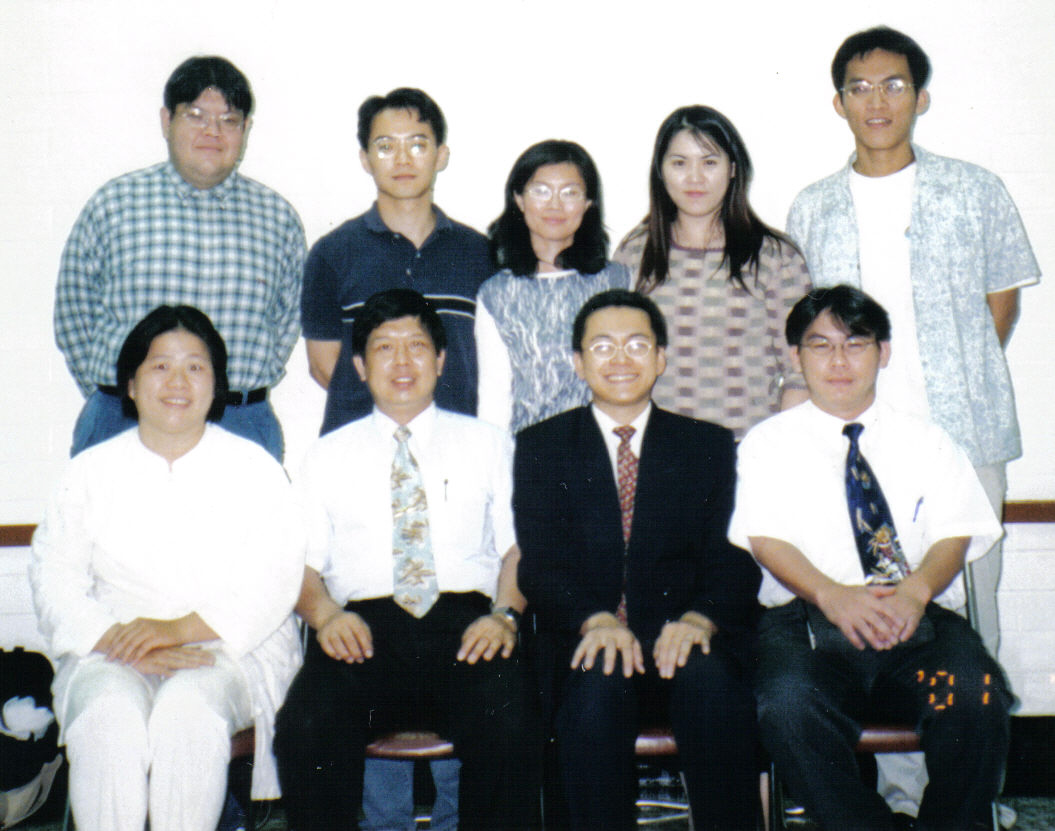 Kaohsiung institute council, first institute council organized in Taiwan on 25 April 2001. Courtesy of Chou Po Nien (Felipe).
Kaohsiung institute council, first institute council organized in Taiwan on 25 April 2001. Courtesy of Chou Po Nien (Felipe).
Moreover, institute course offerings in Taiwan were expanded, and summer institute classes were established. Before 2000, institute course offerings consisted mainly of the four-year scripture-based curriculum (Book of Mormon, Doctrine and Covenants, Old Testament, and New Testament). These courses were retained in the wards and branches, but in 2000, institute course offerings were expanded to include other courses for the YSA institute classes taught in stake centers. These courses included topics such as the Pearl of Great Price, Latter-day Saint history, teachings of the living prophets, preparing for an eternal marriage, and presidents of the Church.[23]
With the addition of summer institute classes, the two-semester institute year was expanded to three semesters. The first summer institute classes began in the southern region in the summer of 2000 despite some concerns it might be poorly attended. Chou would travel and teach at a different stake or district each night of the week from Tuesday to Saturday, covering five stakes or districts in central and southern Taiwan that summer.[24] The combined enrollment for these first five summer institute classes was 907 students, including 174 new students who had not attended during the regular school year but were home for the summer. Following the success of these first summer classes, volunteer institute teachers were enlisted to expand summer class offerings, and summer institute became a typical part of the CES offering.
The changes made to institute programs in the southern region (new convert enrollment efforts, gathering YSAs into larger classes, institute councils, larger institute course offerings, and summer institute) caused institute enrollment to double in the southern region within a year’s time. To assist with the institute growth in the southern region, Chou established a CES office in Taichung, where he supervised the work of John and Janice Sipherd, the first CES missionary couple in Taiwan. Although they did not speak fluent Chinese, they taught with the assistance of local translators, had a great love for the students, and were vital in supporting the growth and expansion of the S&I programs in central Taiwan until they completed their mission in 2002.[25]
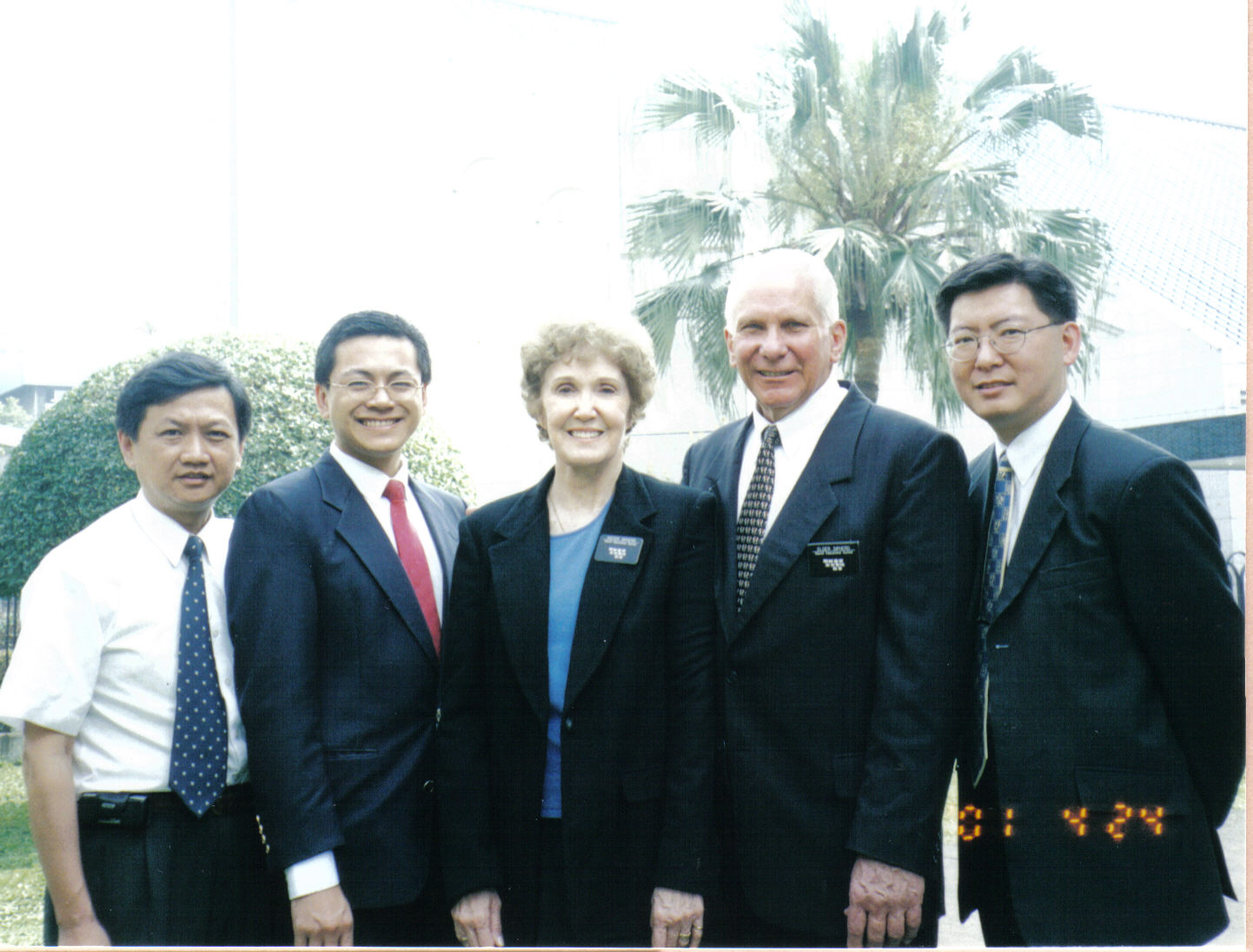 Wang Lu Pao, Chou Po Nien (Felipe), Elder and Sister John Sipherd (first CES missionaires in Taiwan), and Kwok Kam Tim (CES Asia Area Director) on 24 April 2001. Courtesy of Chou Po Nien (Felipe).
Wang Lu Pao, Chou Po Nien (Felipe), Elder and Sister John Sipherd (first CES missionaires in Taiwan), and Kwok Kam Tim (CES Asia Area Director) on 24 April 2001. Courtesy of Chou Po Nien (Felipe).
In 2002, Chou moved with his family to Taichung to open the Taichung office, and Lee Shih-Jung (Robert) (李世榮) was hired as the coordinator in Kaohsiung. The first institute centers for Taiwan, incorporated into the new stake centers, were completed in Kaohsiung and Taichung in 2004, followed by one within the new multistory Church Administration Building in Taipei in 2005.[26] In 2004, Chou was transferred to Taipei to serve as the country director for the CES programs in Taiwan when Wang Lu Pao retired. Chou helped train Wu Chung Kai (Ken) (吳仲凱) and Wang Jung Ling (Riley) (王榕翎), who were hired in 2004 as coordinators for Taichung and Taipei respectively.[27] When Chou and his family were transferred back to the United States in 2005, enrollment for the 2004–5 school year included 487 seminary students (295 early-morning, 192 home study) and 2,787 institute students. In 2009, Wu left S&I employment to pursue other interests, and Weng Wen Shuai (Eric) (翁文帥) was hired in 2011 to fill that vacancy. At the close of the 2014–15 school year, there were 643 seminary and 1,495 institute students in Taiwan.[28]
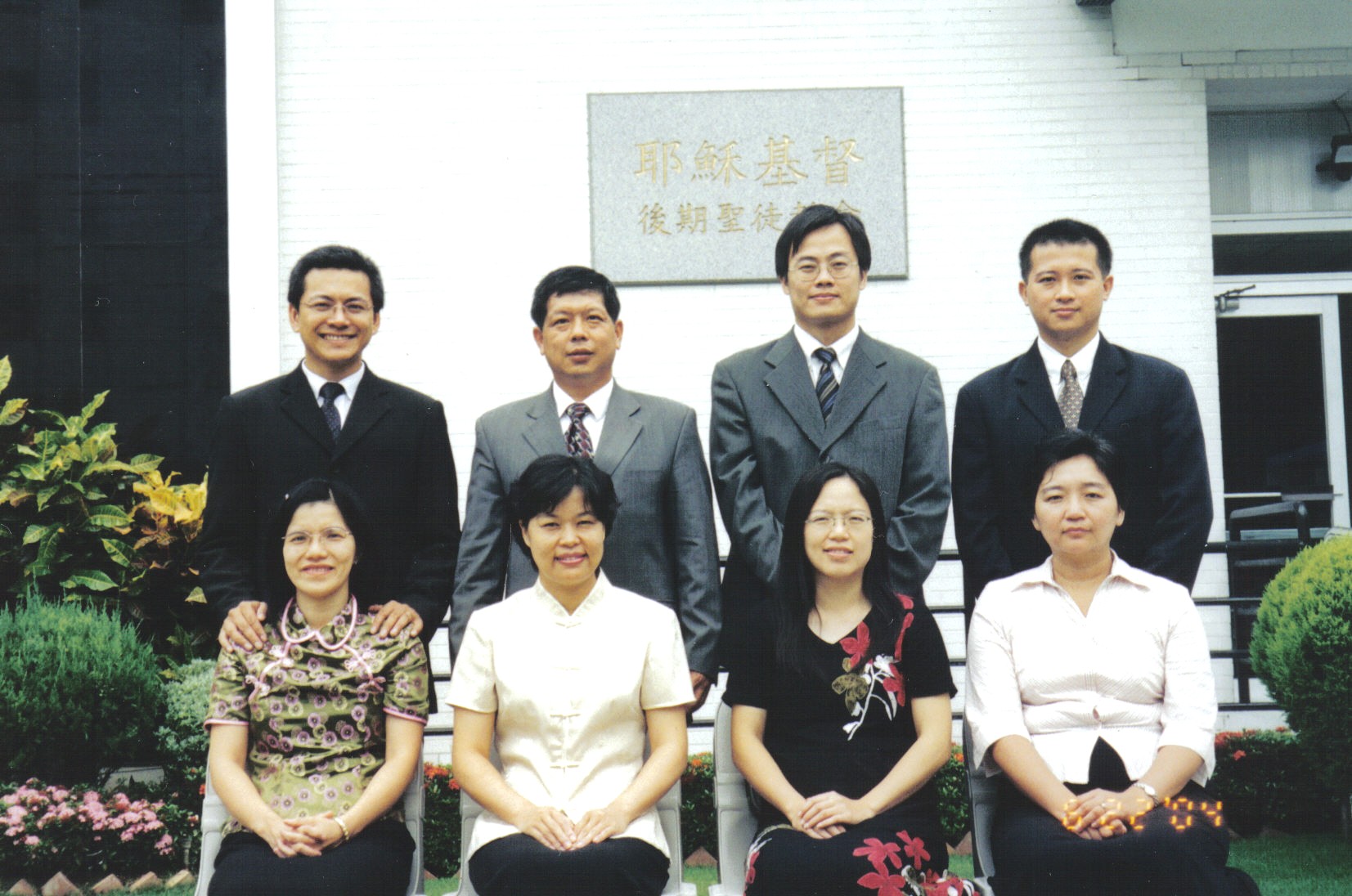 CES coordinators and spouses on 22 June 2004. Chou Po Nien (Felipe) adn Chou Sin Mei Wah (Petra), Lee Shih-Jung (Robert) and Lee Tsai Shu-Min (Bridget), Wang Jung-Ling (Riley) and Wang Lin Ping-Yuan (Annie), Wu Chung-Kai (Ken) and Wu Wang Hui-Ching (Emily). Courtesy of Chou Po Nien (Felipe).
CES coordinators and spouses on 22 June 2004. Chou Po Nien (Felipe) adn Chou Sin Mei Wah (Petra), Lee Shih-Jung (Robert) and Lee Tsai Shu-Min (Bridget), Wang Jung-Ling (Riley) and Wang Lin Ping-Yuan (Annie), Wu Chung-Kai (Ken) and Wu Wang Hui-Ching (Emily). Courtesy of Chou Po Nien (Felipe).
The Impact of Early-Morning Seminary and Institute
The dedicated service of priesthood leaders, volunteer teachers, and CES coordinators continues to strengthen and expand seminary and institute programs in Taiwan. Because of their concerted efforts, early-morning seminary became the ideal and the norm in Taiwan, rather than the exception. Institute programs were also expanded and aligned to serve the YSAs.
Sister Wang Lin Ping-Yuan (Annie) (王林平苑) noted that the change to early-morning seminary was key to Church growth in Taiwan.[29] Lee Shih-Jung (Robert) (李世榮), who served as the stake president for the Kaohsiung Taiwan Stake and also S&I coordinator in Kaohsiung, indicated that early-morning seminary requires sacrifice, thus preparing the young men to sacrifice other pursuits in order to fulfill a full-time mission. Early-morning students study the gospel on a daily basis, increasing their gospel knowledge and testimony of the Savior and his restored Church.[30] Lee’s three children later attended seminary, scored well on their exams, served full-time missions, and attend Brigham Young University.[31]
Sister Chang Wu Nan Hua (張吳蘭花), a mother of two sons who attended early-morning seminary and served honorable missions, believes that early-morning seminary has prompted the youth to stand up to serve, and now there are more local missionaries serving than ever before.[32] In 2015, Brother Huang Yong Da (黃永達) noted that after fifteen years of early-morning seminary in Taiwan, the youth have grown up learning the gospel and are better prepared to teach others.[33]
Nauvoo Temple and Satellite Broadcast of General Conference
During the April 1999 general conference, President Gordon B. Hinckley announced to the worldwide audience his impression to rebuild the Nauvoo temple.[34] In 2002, “satellite broadcasts of the Nauvoo Illinois Temple dedicatory sessions on 27–30 June allowed members gathered at 2,983 sites in 68 countries to take part in the dedication.” Many places, including Taiwan, had never before received a Church satellite broadcast. Several stakes received satellite dishes to provide the members of the Church the rare opportunity to participate in the Nauvoo Temple dedication via a satellite broadcast at their local stake centers.[35] The Church reported, “This was the first temple dedication broadcast on an international scale, . . . [and] an expanded satellite system allowed it to go to areas of the world that have never before received any type of Church satellite broadcast, including . . . Taiwan.”[36]
Lee Shih-Jung (Robert) (李世榮), then the Kaohsiung Taiwan Stake president, recalled when the Church first installed satellite equipment at various stake centers in Taiwan. The Church was preparing for the dedication of the rebuilt Nauvoo temple to be broadcasted via satellite throughout the world. In Kaohsiung, because the stake center was being renovated, the satellite was placed at the Nantze chapel in Kaohsiung, which is where the members viewed the Nauvoo temple dedication.[37] Each member received a special temple recommend ticket, and assigned stake centers served as extensions of the temple for the dedication. Sister Feng Huang Shang-Hua (馮黃上華), a stake Relief Society president in the Kaohsiung Taiwan Stake, said she received her temple card ticket to attend the dedication, but like many others, she had difficulty finding a white handkerchief for the dedication. To resolve this, she and anyone else without a handkerchief cut white fabric to make white handkerchiefs for the members attending the dedication.[38]
After the dedication of the Nauvoo temple, the satellite dishes remained. They were used for CES devotionals (later renamed the Worldwide Devotional for Young Adults), the First Presidency Christmas devotional, and general conference. Having general conference broadcasted was a blessing for the Saints in Taiwan. When it began, due to the time difference, members would attend church on Sunday morning to hear the live Saturday evening priesthood session first, followed by the rebroadcast of the Saturday morning and afternoon session. Later, changes were made and the Saints in Taiwan would participate in general conference on the following Saturday and Sunday, when all the sessions of general conference were rebroadcasted.[39]
Sister Chang Wu Nan-Hua (張吳蘭花), from the Taichung Taiwan East Stake, noted that having the satellite broadcast to hear general conference was a wonderful blessing, and listening to the Mormon Tabernacle Choir “felt like we were in heaven, listening to the choirs of heaven.”[40] Her husband, Chang Chih-Hsun (張志勳), the stake president for the Taichung Taiwan East Stake, added that participating in the satellite broadcast of general conference was like being part of a “heavenly meeting.”[41] Sister Chen Li Mei-Chen (陳李美娟) said that today the words of the living prophets can reach the Saints in Taiwan quickly.[42]
In January 2012, prior to the April general conference, media players were provided to most meetinghouses to facilitate the ability to download, store, and broadcast media files from the Church websites, including various sessions of general conference.[43] Wang Ling-Xing (王令行), the stake president for the Taipei Taiwan East Stake during this time, encouraged the members to go to Church and watch the general conference broadcast together.[44]
Translation of the Name of the Church
The name of the Church was received by revelation by the Prophet Joseph Smith at Far West, Missouri, on 26 April 1838. This revelation recorded in Doctrine and Covenants 115:4 states, “For thus shall my Church be called in the last days, even The Church of Jesus Christ of Latter-day Saints.” Although this name remained the same in English, translation of the name of the Church in various languages has been updated from time to time as better translators and resources became available.
An important change came in 2001 under the direction of the First Presidency and the Quorum of the Twelve, when the Chinese translation of the name of the Church was updated from 耶穌基督末世聖徒教會 to 耶穌基督後期聖徒教會.[45] Prior to 2001, the Chinese translation of “Latter-day Saints” was “末世聖徒” or “mòshì shèngtú,” but thereafter it was translated as “後期聖徒” or “hòuqí shèngtú.” While the former translation had a heavy apocalyptic and doomsday feel that frightened people, the latter was softer in connotation and more acceptable. Overall, it was a more accurate translation, thus helping to improve the image of the Church in Taiwan. In addition, the copyright, lacking throughout the 1990s, also returned in the 2000 edition, which was the last copyright prior to that of the 1987 edition.[46] A 12 January 2001 letter from President Boyd K. Packer, then acting president of the Quorum of the Twelve, stated the following:[47]
Dear Brethren:
Name of the Church in Chinese (To be read in sacrament meeting)
The translation of the name of the Church in Chinese has been a subject of discussion among Church members and leaders for many years. After careful consideration and review by translators, ecclesiastical reviewers, and local and General Authorities, the Council of the First Presidency and Quorum of the Twelve has determined that the translation of the name of the Church in Chinese will be:
耶穌基督後期聖徒教會
Church members should begin to use this name immediately. However, it will take time before all signs, letterheads, literature, etc. will be in compliance with this translation. We ask that you be patient during this period.
Sincerely,
Boyd K. Packer
Acting President
Quorum of the Twelve[48]
Sister Chiu Hsin-Yao (Lena) (邱欣遙), who was baptized in Nantze and later served as a full-time missionary for the Church, said that the members had to get used to the new translation. Nevertheless, it was significantly better as the old translation had an alarming and apocalyptic feel that she often had to explain to nonmembers, including her family.[49] The image of the Church in Taiwan continued to improve. Elder Juan Jui-Chang (阮瑞昌), then the Taiwan Taichung Stake president in 2001, noted, “Many Chinese people invite the missionaries to come to their homes because they just cannot believe that in modern days, filled with such temptation, you still have such nice young men, nicely dressed, coming all the way from America to serve our country. Very nice clothes, you know, all out of their own expense. So they are very impressed with their sacrifice and their love.”[50] Today, many Taiwanese people are quick to recognize two young men wearing white shirts and ties and riding bicycles.
Area Seventies from Taiwan
During the 2000s, several men from Taiwan served as Area Seventies after the first Area Seventy, Elder Lian Shih-An (Kent) (梁世安), served until he was released on 1 October 2003. Many of these new members of the Quorum of the Seventy were seasoned local leaders with years of experience in the Church, most had served before as stake presidents, bishops, or high councilors. For instance, Elder Yang Tsung-Ting (Jared) (楊宗廷) was the second Area Seventy called from Taiwan, serving between 2000 and 2008. Elder Ho Yu-Chen (Philip) (何於振) would also serve as an Area Seventy from 2003 to 2010, then becoming the Taipei temple president from 2012 to 2015. President Hinckley outlined the responsibilities of Area Seventies:
They may be assigned to (a) preside at stake conferences and train stake presidencies; (b) create or reorganize stakes and set apart stake presidencies; (c) serve as counselors in Area Presidencies; (d) chair regional conference planning committees; (e) serve on area councils presided over by the Area Presidency; (f) tour missions and train mission presidents; and (g) complete other duties as assigned.[51]
Area Authority Seventies “helped [to] carry the heavy responsibilities that rest upon the shoulders of the First Presidency, the Quorum of the Twelve Apostles, and the First and Second Quorums of the Seventy.” The First and Second Quorums of Seventies were created in 1975 and 1989 respectively, and are designated General Authority Seventies with jurisdiction throughout the world. When Area Authority Seventies were called in 1997, they were organized into the Third, Fourth, and Fifth Quorum of the Seventy. The organization of these Quorums of the Seventy were geographical in nature, with jurisdiction limited to their area.[52] In 2004, the Fifth Quorum of the Seventy was divided to create the Sixth Quorum. Then in May 2005, the Third and Fourth Quorums were divided to create the Eighth and Seventh Quorums of the Seventy respectively. Although Area Seventies from Asia, including those from Taiwan, were initially part of the Third Quorum of the Seventy, they would later be assigned to the Eighth Quorum.
Elder Yang Tsung-Ting (Jared)
Elder Yang Tsung-Ting (Jared) (楊宗廷) from Taipei was fifty-two years old when he became the second person from Taiwan to be called as an Area Seventy. He grew up in a Buddhist home and picked up some bad habits after his military service. His sister lent him the book The Brightness of Life, which taught him how to overcome bad habits through the power of Christ. A coworker who was a member of the Church invited him several times to church. He finally went to an open house at her church but hesitated because he could not find her and was worried about leaving his new car in the street. However, he was touched by the welcome he received by the members at the open house, and a sister offered to watch his car while he was in the chapel. As he witnessed the good examples from members of the Church, he felt the Holy Ghost, which gave him power to quit drinking and smoking.[53]
Yang’s parents were against him joining the Church, so he eventually was forced to decide between obeying his parents and following the Lord. He put his trust in the Lord and was baptized on 6 April 1973, when he was twenty-five years old. Although his parents didn’t join the Church, they eventually developed a good impression of the Church as they saw full-time missionaries who were polite, smiling, and well-groomed. In 1975, Yang met his wife, Yang Kuei Shu-Feng (楊桂書鳳), and they were married on 24 September. On 22 April 1976, when the Taipei Stake was created, Elder Gordon B. Hinckley ordained him a high priest and set him apart as the bishop of the Third Ward. In 1981, Yang traveled with his wife and children to the Tokyo Japan Temple to be sealed together as an eternal family.[54]
Elder Yang was an accountant by profession before he began working for the Church Service Center in March 1999. He was serving as the stake president for the Taipei Taiwan West Stake (1992–2001) at the time of his call as an Area Seventy. His wife, Sister Yang, is from Kaohsiung and served as teacher improvement coordinator, stake Primary president, ward Relief Society and Primary president, youth Sunday School, seminary, and institute teacher. The Yangs have three children; their oldest son was serving in the navy, their second son was studying at BYU–Hawaii, and their daughter was at Dan Jiang (淡江) college[55] when Elder Yang was called as Area Authority Seventy on 2 October 2000. He would serve the members in Taiwan and throughout Asia in that calling until 1 May 2008.[56]
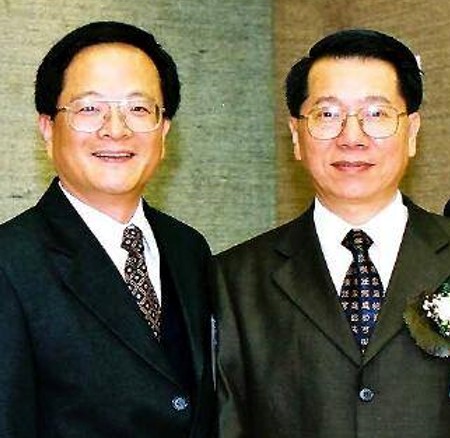 Left to right: Elder Ho Yo-Chen (Philip) and Elder Tang Tsung-Ting (Jared) served as Area Seventies from Taiwan, circa 2003. Courtesy of Ho Yu-Chen and Yang Tsung-Ting.
Left to right: Elder Ho Yo-Chen (Philip) and Elder Tang Tsung-Ting (Jared) served as Area Seventies from Taiwan, circa 2003. Courtesy of Ho Yu-Chen and Yang Tsung-Ting.
Elder Ho Yu-Chen (Philip)
Elder Ho Yu-Chen (Philip) (何於振) was called as an Area Seventy on 1 April 2003.[57] Prior to this call he served as a bishop, a counselor in a missionary presidency, and the stake president of the Taipei Taiwan East Stake from January 1990 to January 1993. Elder Ho was born in Hualien and worked as a general manager of Beijing Millard Meeting Services Limited Company. He also served as a counselor in the Taipei Taiwan Temple presidency before being called as the temple president on 22 October 2012. His wife, Ho Lee Mei-Chen (何李梅珍) served as the temple matron with him.[58] Elder Ho was baptized in 1966, while Sister Ho joined the Church in 1978. They were among the few couples who went to the Japan Tokyo Temple in 1983 to be sealed, and both served in various callings in the Church.[59]
When Elder Ho was just a little boy, he got very sick after hiking one day. His mother tried to find help, but she was unable to find any. Previously, his mother learned about prayer from a Christian pamphlet, so she began to pray. According to Ho, missionaries from the Church soon came to their door. After learning about priesthood blessings, his mother requested that the missionaries would bless her son. The follow-up doctor’s visit after this blessing revealed that Ho’s health miraculously improved, and the family was baptized shortly after.[60]
Sister Ho’s mother began attending the Catholic Church when she was very young. Later, while dating her future husband, she investigated the Church. Her Catholic priest told her that the LDS Church was good, and then a coworker mentioned that she should consider the value of “one religion for one family.” Sister Ho recalled that she attended the Church and had a positive experience; she decided to leave the Catholic Church and join the LDS Church because of the words of her coworker.[61] Sister Ho, born in Yangmei, previously served as an assistant to the matron of the Taipei Taiwan Temple, a stake and ward Relief Society president, a ward Young Women president’s counselor, and the ward Primary president.[62] She is an example of the numerous faithful and dedicated women of the Church throughout Taiwan. She has, for example, served three times as a ward Relief Society president.
Visits with Church and Government Leaders
Church leaders and members in Taiwan benefitted from the teaching and training of various leaders, particularly from general authorities and general auxiliary leaders who visited Taiwan. These visitors included members of the Quorum of the Twelve, including Elder L. Tom Perry and Elder Dallin H. Oaks, as well as the Presiding Bishop of the Church and the Relief Society general president of the Church. Each visit was a blessing to the Saints in Taiwan, providing training and encouragement, thereby strengthening faith and dedication in the establishment of Zion in Taiwan.
Sister Hsu Hsiu-Ying (徐秀瑛) recalled that in 2001, Elder Perry talked about his family during a special session held in Taipei for the members in northern Taiwan, and she remembered the wonderful spirit that was present during the meeting.[63] Sister Lee Tsai Shu-Min (李蔡淑敏) remembered shaking hands with Elder Oaks after the 2002 fireside in Kaohsiung, where Elder Oaks introduced Sister Lee to his wife and then asked each of the Lees’ children if they planned on serving a full-time mission in the future.[64] Chang Jui-Sheng (張瑞昇) from Taichung noted that Elder Oaks held firesides in Taipei and Kaohsiung, but chose not to hold a fireside in Taichung since it was Monday, family home evening night. Although the members in Taichung missed having a fireside, Chang said that Elder Oaks’s decision left a strong impression of the importance of respecting the night set aside by the Church for families to gather for family home evening.[65]
In addition, Church leaders visited with various government leaders who recognized the humanitarian efforts of the Church in Taiwan. Following the global economic downturn from the 11 September 2001 terrorist attacks in the United States, a major category three typhoon brought torrential rainfall and mudslides that caused severe damage to homes, businesses, and infrastructure in the northern region of Taiwan. Typhoon Nari left an estimated 650,000 people without water, 350,000 without water and telephone service, and 10,000 people needing to relocate in north and central Taiwan. To aid relief efforts, local Church leaders received sixty thousand US dollars from LDS Charities to purchase supplies and hire local contractors to help with reconstruction efforts.[66]
Local Taiwanese government officials were most appreciative of the donated service and supplies. On 29 October 2001, Brother Gary L. Winters from LDS Charities, accompanied by Wan Tak-Chung (Stanley) (溫德中) and Elder and Sister Adamson, was invited to the Taiwan presidential mansion to meet with Lu Hsiu-lien (呂秀蓮), vice president of Taiwan. The next morning, the LDS Charities delegation met with the Taipei city mayor, Ma Ying-jeou (馬英九) to be recognized and receive a certificate of appreciation for their generosity.[67]
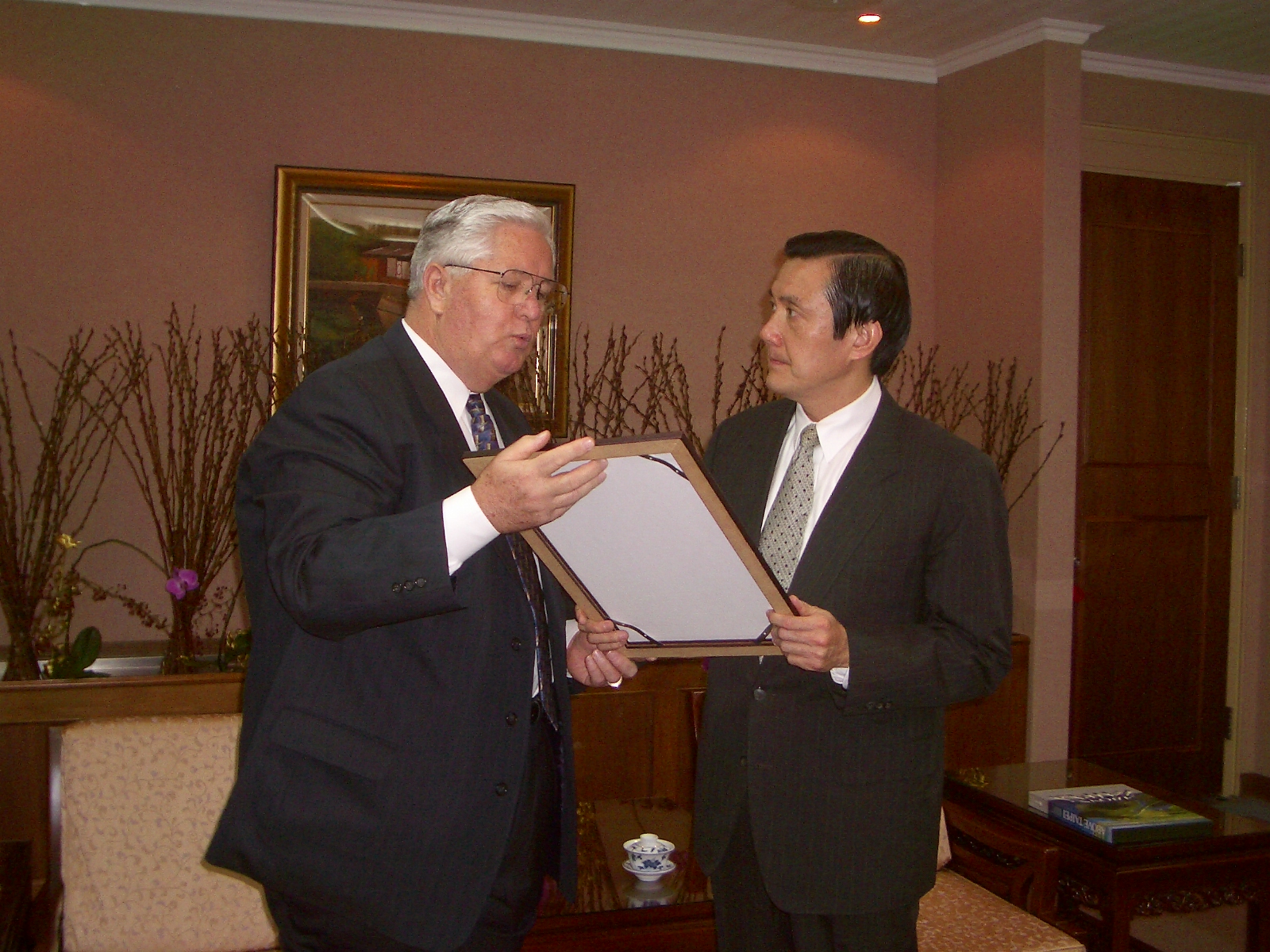 Bishop H. David Burton (Presiding Bishop of the Church) visits Taipei city mayor Ma Ying-jeou on 20 February 2004. Courtesy of Taipei Church History Center.
Bishop H. David Burton (Presiding Bishop of the Church) visits Taipei city mayor Ma Ying-jeou on 20 February 2004. Courtesy of Taipei Church History Center.
On 20 February 2004, Bishop H. David Burton, then the Presiding Bishop of the Church, visited Taiwan to inspect the progress on the construction of the new Church Administration Building in Taipei. During his trip, he visited with Ma Ying-jeou, then the Taipei city mayor. Bishop Burton was accompanied by several Church representatives, including the director of temporal affairs, Brother Wayne Facer, and an Area Seventy from Taiwan, Elder Ho Yu-Chen (Philip) (何於振). Mayor Ma thanked the Church for its assistance during the 2001 Typhoon Nari and also recognized the work of the missionaries in Taiwan.[68]
On 17 February 2005, Sister Bonnie D. Parkin, the Relief Society general president, was accompanied by President D. Allen Andersen of the Asia Area Presidency and Elder Tsung-Ting (Jared) (楊宗廷), an Area Seventy, when she met with leaders of women’s organizations in Taiwan and the Taipei mayor, Ma Ying-jeou. Sister Parkin shared with Mayor Ma the importance of families and the family home evening program of the Church. Various news outlets reported on her visit.[69]
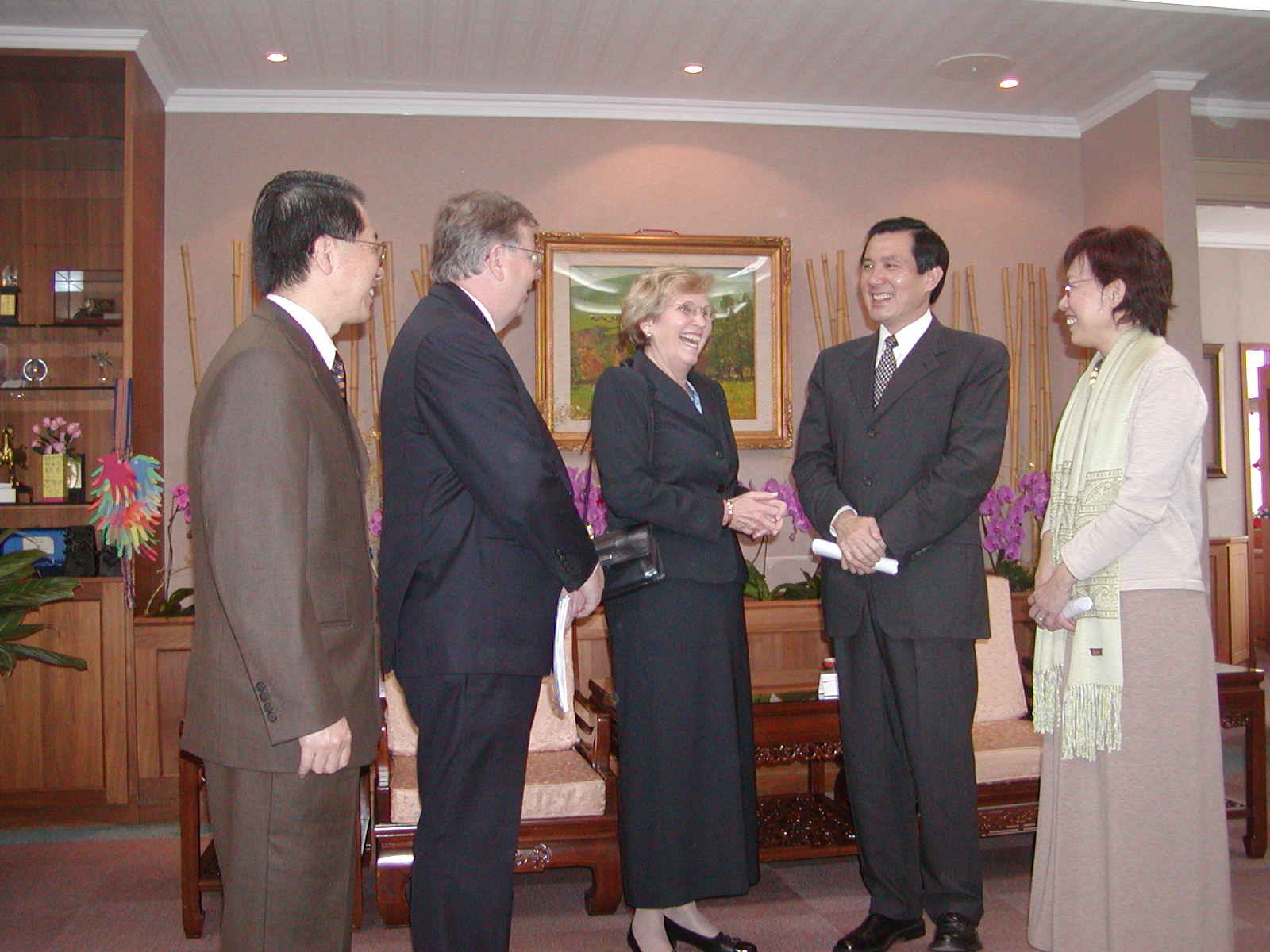 Sister Bonnie D. Parkin (Relief Society general president) visits Taipei city mayor Ma Ying-Jeou to discuss the family home evening program on 17 February 2005. Courtesy of Taipei Church History Center.
Sister Bonnie D. Parkin (Relief Society general president) visits Taipei city mayor Ma Ying-Jeou to discuss the family home evening program on 17 February 2005. Courtesy of Taipei Church History Center.
SARS Outbreak in Asia
A deadly outbreak of severe acute respiratory syndrome (SARS) affected many countries in North America, South America, Europe, and Asia—including Taiwan. The SARS virus was spread from one person to another through the air—an infected person infected another by coughing or sneezing in close proximity.[70] The SARS epidemic claimed 774 deaths out of nearly 8,100 cases reported between November 2002 and July 2003 before it was contained. The virus is believed to have originated in China, spreading to Hong Kong, Taiwan, and various other countries in Asia. It was eventually reported widely in the media in early 2003. By March of that year, the United Nation’s World Health Organization (WHO) and later the United States Centers for Disease Control and Prevention (CDC) issued a global health alert.[71]
Medical personnel who labored throughout this crisis worked in close proximity to patients affected by SARS. Sister Chen Ching-chiu (陳靜秋) from the Hsin Tien Ward of the Taipei West Stake became the first medical worker to die of SARS in Taiwan on 1 May 2003. She was survived by her husband and her seven-year-old. Sister Chen was baptized in January 2002. She was a head nurse at the Taipei Municipal Ho Ping Hospital when she contracted SARS while caring for SARS patients at the hospital in April. Taiwan president Chen Shui-bian (陳水扁) awarded her a presidential commendation and noted that “her selfless spirit . . . is an example to all medical workers.” Taipei Mayor Ma Ying-jeou (馬英九) and city officials recognized Sister Chen and her family by holding a one-minute of silence the day after her passing. Ma paid tribute to Sister Chen, saying that she was “the first soldier who sacrificed herself fighting SARS”[72] and that while “she died a brave fighter in the battle against SARS, I hope her efforts will lead us to the final victory against the epidemic.”[73]
When the SARS outbreak was initially reported, members were encouraged to wear masks to prevent being infected with this airborne respiratory illness. Eventually, under the direction of President John B. Dickson, the Asia Area president and member of the Quorum of the Seventy, Church meetings and activities were suspended for a few weeks throughout Taiwan. During this stressful period, members were encouraged to hold sacrament meeting in their home if they had a priesthood holder who could administer it. Those without a priesthood holder in the home were encouraged to spend the Sabbath studying the gospel with their families.[74]
Preach My Gospel
In June 2004, Elder M. Russell Ballard of the Quorum of the Twelve Apostles, who was also chairman of the missionary committee of the Church, introduced Preach My Gospel to over one hundred new mission presidents at the Provo Missionary Training Center. Then, on 15 October 2004, Preach My Gospel was introduced via a worldwide satellite broadcast to mission leaders in all 338 missions of the Church. During the broadcast, Elder Ballard said, “Under the direction of the First Presidency and the Quorum of the Twelve Apostles, Preach My Gospel has been produced. . . . Every word has been studied by the full First Presidency and the Quorum of the Twelve; this has their complete and total blessing and endorsement.”[75]
In November 2004, Preach My Gospel was introduced to the general membership of the Church. The missionary lessons found in Preach My Gospel were “a return to the unscripted preaching of early Church missionaries and a step forward, providing missionaries with greater support materials that have been developed based on many years of experience.”[76] Sister Tsai Lin (Cassandra) (蔡琳), then the Chinese language supervisor for the Church’s translation department in Taipei, noted the urgency to translate Preach My Gospel into Chinese as soon as possible. While translation projects were generally placed in a queue to organize translation priorities, Preach My Gospel jumped to the top of the queue for immediate translation.[77]
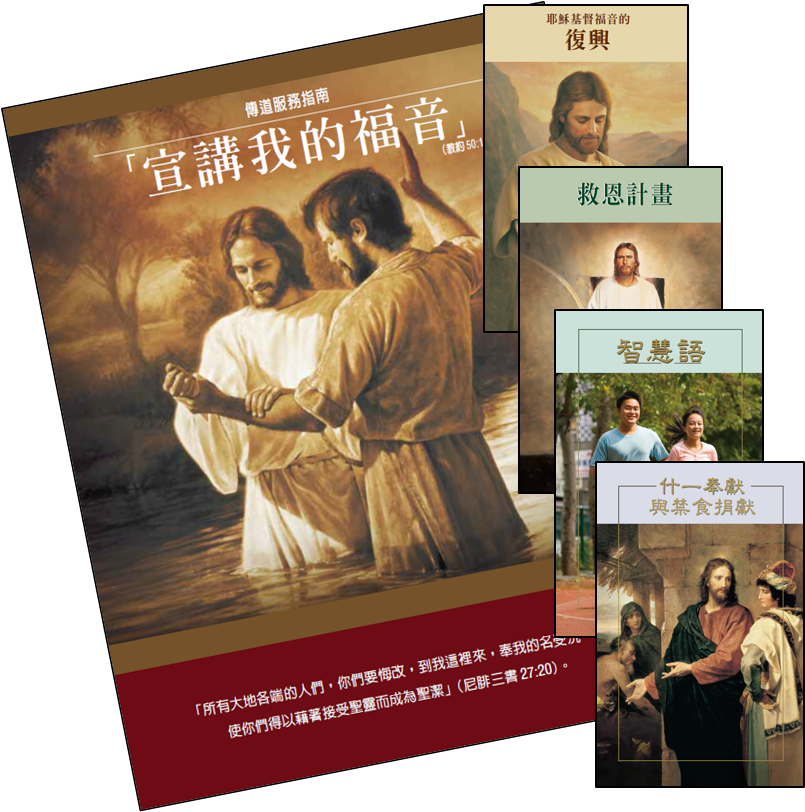 Copy of Preach My Gospel and accompanying pamphlets in 2004. Courtesy of Chou Po Nien (Felipe).
Copy of Preach My Gospel and accompanying pamphlets in 2004. Courtesy of Chou Po Nien (Felipe).
Moreover, in the early 2000s, Church websites came online to provide further resources for members and nonmembers in various languages, including Chinese. These consisted of lds.org and providentliving.org, and were created to teach and strengthen members and new converts. Additional Church websites included familysearch.org to facilitate genealogy and mormon.org to share the gospel.[78]
Over the years, Sister Tsai Lin (Cassandra) (蔡琳) noted the blessing it was to provide translated Church materials to the members. She stated that “working as a language supervisor for the Church is not just a job. It is a great privilege and blessing.”[79] The previous missionary discussion lessons, dubbed the “rainbow discussions” because each discussion lesson booklet was a different color, fulfilled their purpose during a time when missionaries memorized the booklets in preparation to teach investigators. In contrast, Preach My Gospel provided lessons that were led by missionaries using their own words to teach under the direction of the Holy Ghost. This made the lessons adaptable to the needs of their investigators, thus providing the missionary lessons necessary for our time. One LDS scholar concluded, “In the years to come, we will see the long-term effect Preach My Gospel will have on convert retention, returned missionary retention, missionary baptismal productivity, and missionary effectiveness in teaching the gospel of Jesus Christ.”[80]
The experience of Sister Chiu Hsin-Yao (Lena) (邱欣遙) illustrates the blessings received after the implementation of Preach My Gospel and the experience of Taiwanese missionaries at the Philippines Missionary Training Center. When Chiu was baptized in 1997, the missionaries used the six missionary discussion lessons, or the “rainbow discussions” to teach her, which “they would basically memorize and recite word for word, with no variation or flexibility.” When she was called as a full-time missionary to serve in the California Santa Rosa Mission in 2004, she entered the Provo MTC when they were still utilizing the “rainbow discussions” but were also piloting Preach My Gospel.[81] Chiu’s mission was among those selected to pilot missionary planners and a chapter from Preach My Gospel until the new resources officially replaced the “rainbow discussions.” Sister Chiu said, “The new lessons and method of teaching provided by Preach My Gospel allowed missionaries the flexibility of adapting the lessons to the needs of their investigators as directed by the Spirit. They were so much better and allowed for a conversation rather than a memorized recitation of the gospel principles you were trying to teach.”[82]
Conclusion
This period of Church history welcomed the dawn of a new rising generation of Latter-day Saints, with new programs and resources to help deepen their conversion, prepare for missions, and further the Lord’s work. They were benefitted by the establishment of the early-morning seminary program in Taiwan, the arrival of satellite technology to afford them the opportunity to participate in general conference, the updated Chinese translation of the name of the Church, and the use of Preach My Gospel. Despite the challenges brought by the SARS epidemic in Asia, the call of Area Seventies from Taiwan and visits with Church leaders and government officials built and strengthened relationships between the Church and the Taiwanese government.
Notes
[1] A version of this section appears in print in John Hilton III and Chou Po Nien (Felipe), “The History of LDS Seminaries and Institutes in Taiwan,” Mormon Historical Studies 14, no. 2 (Fall 2013): 83–106; “News of the Church: New Area Presidency Assignments,” Ensign, September 1999, 74–75.
[2] Chou, personal history and journal entries, 2000–2005.
[3] Liang Shih-Wei, “Leadership Pattern Asia—Building Capability,” 25 April 2013, internal memo to Church employees in Asia, copy in possession of authors.
[4] Liang Shih-Wei, “Leadership Pattern Asia - Building Capability.”
[5] Chou Po Nien (Felipe), “CES Coordinator in Kaohsiung,” Liahona (Chinese), October 2000, n-16.
[6] Chou, personal history and journal entries, 2000–2005.
[7] Chou Po Nien (Felipe), “Early Morning Seminary Special Report: Kaohsiung Stake,” Liahona (Chinese), October 2000, n-13.
[8] Chou Po Nien (Felipe), “CES Activity Report: Kaohsiung-Pingtung Area Combined Graduation,” Liahona (Chinese), February 2001, n-12; and Chou, personal history.
[9] Chou, personal history and journal entries, 2000–2005.
[10] Chou, “CES Activity Report,” n-12.
[11] Chou, personal history and journal entries, 2000–2005.
[12] Chou Po Nien (Felipe), “Seminary and Institute,” Liahona (Chinese), October, 2004, n-10.
[13] Chou, personal history and journal entries, 1999–2000.
[14] Chou, personal history and journal entries, 1999–2000.
[15] Chou, personal history and journal entries, 1999–2000.
[16] Chou, personal history and journal entries, 1999–2000.
[17] Chou, personal history and journal entries, 1999–2000.
[18] Chou, personal history and journal entries, 1999–2000.
[19] Chou, personal history and journal entries, 1999–2000.
[20] Chou, personal history and journal entries, 1999–2000.
[21] Chou, personal history and journal entries, 1999–2000.
[22] Chou, personal history and journal entries, 1999–2000.
[23] Chou, personal history and journal entries, 1999–2005.
[24] Chou, personal history and journal entries, 1999–2005.
[25] Chou, personal history and journal entries, 1999–2005.
[26] “President Hinckley Travels the World,” Ensign, October 2005, 72.
[27] Chou, personal history and journal entries, 1999–2005. In 2011, Weng Wen Shuai (Eric) replaced Wu Chung Kai.
[28] Seminaries and Institutes of Religion Annual Report for 2013, 3.
[29] Wang Lin Ping-Yuan, interview by Chou Po Nien (Felipe), 22 November 2015, Taipei, Taiwan.
[30] Lee Shih-Jung (Robert), interview by Chou Po Nien (Felipe), 29 August 2015, Provo, UT.
[31] Brenda Frandsen to Chou Po Nien (Felipe), email, 12 February 2016.
[32] Chang Wu Nan Hua, interview by Chou Po Nien (Felipe), 14 November 2015, Taichung, Taiwan.
[33] Huang Yong Da, interview by Chou Po Nien (Felipe), 13 November 2015, Taichung, Taiwan.
[34] “President Hinckley and the Nauvoo Temple,” Ensign, July 2002, 24–25.
[35] “News of the Church: Nauvoo Temple Dedication around the World,” Ensign, October 2002, 75–76.
[36] “News of the Church: Nauvoo Illinois Temple Dedication,” Ensign, September 2002, 74–75.
[37] Lee Shih-Jung (Robert), interview by Chou.
[38] Feng Huang Shang-Hua, interview by Chou Po Nien (Felipe), 17 November 2015, Kaohsiung, Taiwan.
[39] Lee Shih-Jung (Robert), interview by Chou.
[40] Chang Wu Nan-Hua, interview by Chou.
[41] Chang Chih-Hsun, interview by Chou Po Nien (Felipe), 14 November 2015, Taichung, Taiwan.
[42] Chen Li Mei-Chen, interview by Chou Po Nien (Felipe), 14 November 2015, Taichung, Taiwan.
[43] Kevin R. Nield, “Media Players for Viewing General Conference—April 2012,” letter from the director of temporal affairs dated 30 January 2012, copy in possession of authors.
[44] Wang Ling-Xing, interview by Chou Po Nien (Felipe), 20 November 2015, Taipei, Taiwan.
[45] Brittany Karford, “News of the Church: Taiwan Jubilee, Saints Celebrate 50 Years,” Ensign, July 2006, 77.
[46] Tyler Thorsted, interview by Chou Po Nien (Felipe), 20 March and 2 April 2015, Salt Lake City.
[47] Boyd K. Packer, “Name of the Church in Chinese,” letter from the office of the Quorum of the Twelve Apostles, 12 January 2001, copy in possession of authors.
[48] Packer, “Name of the Church in Chinese.”
[49] Chiu Hsin-Yao, interview by Chou Po Nien (Felipe), 22 October 2015, Provo, UT.
[50] Juan Jui-Chang, oral interview by Church History Library, 20 October 2001, Taipei, Taiwan.
[51] Gordon B. Hinckley, “May We Be Faithful and True,” Ensign, May 1997, 5–6.
[52] Earl C. Tingey, “Area Authority Seventies: ‘To Bear Record of My Name in All the World,’” Ensign, October 2002, 50–55.
[53] Richard Stamps and Wendy Shamo, The Taiwan Saints (self-published book commemorating the fortieth anniversary of the Church in Taiwan, 1996), 23–25.
[54] Stamps and Shamo, The Taiwan Saints, 23–25.
[55] “New Area Seventy in Asia,” Liahona (Chinese), February 2001, n-6.
[56] Dieter F. Uchtdorf, “The Sustaining of Church Officers,” Ensign, May 2008, 4–6.
[57] James E. Faust, “The Sustaining of Church Officers,” Ensign, May 2003, 23–24.
[58] “New Temple Presidents,” Church News, 13 May 2012, 12.
[59] Ho Yu-Chen (Philip), interview by Chou Po Nien (Felipe), 19 November 2015, Taipei, Taiwan; Ho Lee Mei-Chen, interview by Chou Po Nien (Felipe), 19 November 2015, Taipei, Taiwan.
[60] Ho Yu-Chen (Philip), interview by Chou; Ho Lee Mei-Chen, interview by Chou.
[61] Ho Yu-Chen (Philip), interview by Chou; Ho Lee Mei-Chen, interview by Chou.
[62] “New Temple Presidents,” Church News, 13 May 2012, 12.
[63] Hsu Hsiu-Ying, interview by Chou Po Nien (Felipe), 20 November 2015, Taipei, Taiwan.
[64] Lee Tsai Shu-Min (Bridget), interview by Chou Po Nien (Felipe), 16 November 2015, Kaohsiung, Taiwan.
[65] Chang Jui-Sheng, interview by Chou Po Nien (Felipe), 14 November 2015, Taichung, Taiwan.
[66] “Latter-day Saint Charity’s Vice President Visits Taiwan,” Liahona (Chinese), March 2002, n-9.
[67] “Latter-day Saint Charity’s Vice President Visits Taiwan,” n-9.
[68] “Bishop Burton Meets with Taipei Mayor Ma Ying-jeou,” Liahona (Chinese), June 2004, n-9.
[69] Luan Chi Xiong, “General Relief Society President, Sister Bonnie Parkin Visits Taiwan,” Liahona (Chinese), June 2005, n-11–12.
[70] “SARS Basics Fact Sheet,” Centers for Disease Control and Prevention, retrieved on 14 September 2015, http://
[71] “Severe Acute Respiratory Syndrome,” Wikipedia, retrieved on 14 September 2015, https://
[72] Emily Chien and Linda Thornell, “News of the Church: SARS Claims Sister, Impacts Church in Asia,” Ensign, July 2003, 77.
[73] Debby Wu, “Two More Die as City Plans Cleanup,” Taipei Times, 2 May 2003.
[74] Chou, personal history and journal entries, 1999–2005.
[75] M. Russell Ballard, in “Preach My Gospel: Introduction for Leaders,” Missionary Training Satellite Broadcast, 15 October 2004, DVD.
[76] Adam C. Olsen, “New Preach My Gospel Program Being Launched in Missions Worldwide,” Ensign, January 2005, 75.
[77] Chou Po Nien (Felipe), personal history and journal entries, 2004–5.
[78] “Using Mormon.org to Share the Gospel,” Liahona (Chinese), December 2005, n-5–7.
[79] Cassandra Lin Tsai, “It Wasn’t a Sacrifice,” Ensign, March 2004, 52–53.
[80] Benjamin Hyrum White, “The History of Preach My Gospel,” Religious Educator 14, no. 1 (2013): 129–58.
[81] Chiu Hsin-Yao, interview by Chou.
[82] Chiu Hsin-Yao, interview by Chou.
